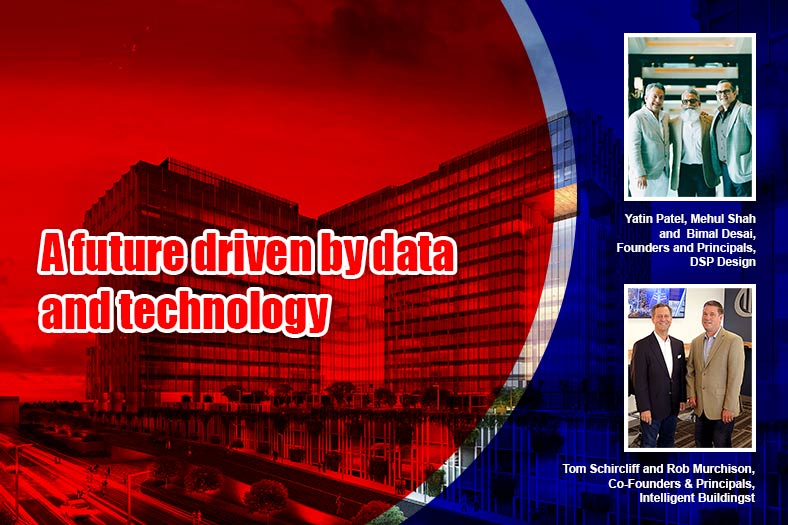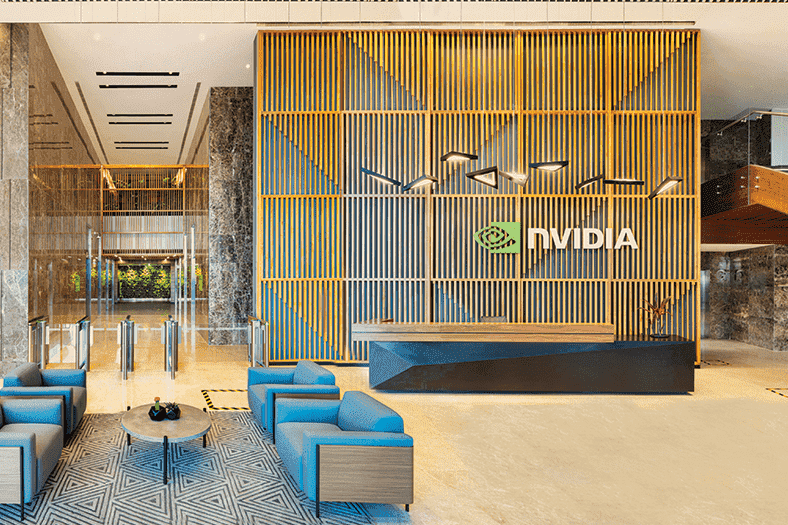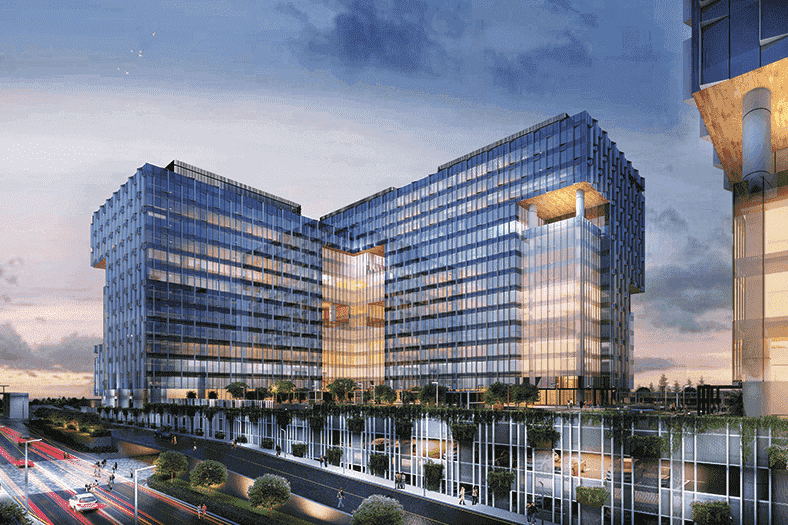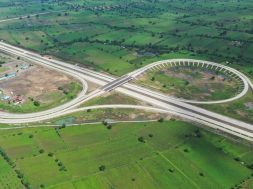A future driven by data and technology

Five experts at DSPIB elucidate on the role of technology and data on the buildings of the future and how design intertwines itself in this beautiful arrangement.

Nvidia Workplace by DSP Design | Photography Credits: Andre Fanthome, Noughts & Crosses
How has the pandemic brought out the importance of architecture & smart building design?
Rob Murchison, (Co-Founder & Principal – Intelligent Buildings):It has shocked the industry in to remote work, evolving into hybrid work, which changes the view of the traditional office space for example and brings forward more flexible, collaborative and less permanent work spaces. We are also seeing the pandemic legacy of intensified attention to the indoor environmental conditions referred to above.
What’s in it for multinational corporations looking to set up responsive campuses & spaces?
Rob Murchison, (Co-Founder & Principal – Intelligent Buildings):Multinational Corporations must have a design that is technology driven and offers ultimate flexibility in both short-term and long-term use of the space. This requires physical changes and virtual changes ranging from spaces that are shaped to guide occupant’s behavior and choices to building systems that react to presence, reservations and density. The added dimension of time to the design equation is much more important since workers will not be as “9-5” as before and may be more shift oriented or prone to come in based on ad hoc collaboration opportunities.
What are some of the issues that have caused this combination of design and technology?
Bimal Desai, (Founder & Principal – DSP Design): While the pandemic has been a tremendous catalyst, the advancement of building systems and overall prop tech has imbued nearly every project going forward with a technology heartbeat in the occupant experience, as well as the building performance approach and more urgently the risk management from a cybersecurity and vendor risk management perspective.
What role will data and technology play in achieving sustainability and wellness in the built environment?
Yatin Patel (Founder & Principal – DSP Design): To have lasting sustainability as opposed to a one-time certification or designation and to have an enhanced indoor environment the use of data and technology become imperative. The buildings are constantly changing along with new occupants, use types, use cases and even weather and environmental seasonality. One must (by original design and specification) be able to get data, integrate systems and provide for better manual and automated decision making.
How is India and the world utilizing these technologies to create habitats of the future?
Yatin Patel (Founder & Principal – DSP Design): Nearly everything needs to be measured with systems and sensors including indoor air quality (IAQ) such as CO2, CO, PM, humidity, daylight, water conditions in potable and process water, surface and cleaning schedules, space utilization and many others. Furthermore, the systems are required to be connected and integrated for reacting to this data to sequence one system to another for achieving a changing use case in performance, experience and risk management. The DSPIB culmination commits in driving a transition from these activities that are currently being performed in silos and as fragmented approaches by initiating a change via design!

Ascendas India Campus by DSP Design
What is DSPIB all about?
Bimal Desai, (Founder & Principal – DSP Design): The real estate industry has been faced with an unprecedented convergence of issues accounting for energy, sustainability public health, occupant experience for attraction and retention, cyber security, hybrid working among others. This has become untenable for owners and operators and they must have fewer “moving parts” and fewer so-called experts. We have already seen this play out with examples of large projects or portfolios that are led by strategic resources that drive most other downstream tactical construction, technology and property management. The leaders at DSP and IB have seen this developing and have admirably grasped and anticipated the client-endrequirements. This coming together of Design & Technology forces has resulted in leading edge real estate solutions for across the spectrum spatial complexities.
What are the tangibles to this unified Design + Technology wave that you have endeavored to have the industry experience with DSPIB?
Tom Schircliff, (Co-Founder & Principal – Intelligent Buildings):The tangibles are that for the first time in the industry the clients can have a single contract and single set of deliverables with design and technology combined. This will allow the design lead to guide technology and engineering requirements in a seamless way as opposed to the historically disjointed process. How does this relate to environmental sensitivity? Environmental sensitivity and stewardship requires a comprehensive view using design, materials, sensors, systems and knowledge of property and facility management process and workflows. We have not only blended design and technology but the recommendations go deeper into the ongoing management impact that any design approach in the industry.
Together with DSP, one of the celebrated leaders in Indian architecture and design, what kind of projects are you executing?
Tom Schircliff, (Co-Founder & Principal – Intelligent Buildings): This is having been a thoughtful multi-year process that was more of a measure twice, cut once approach. Since it was an innovation in real estate services, we owed it to our customers to be thorough in our thought process and now post-pandemic we are beginning a number of engagement conversations with large real estate companies and organizations including multi-nationals and in-country real estate developers and managers.
What’s your “Innovation Bet” to the industry as the first movers on this front having seen it all through the pre-pandemic to post pandemic times?
Mehul Shah,(Founder & Principal – DSP Design): These are obvious but real “innovation bets” of Internet of Things (IoT), artificial intelligent (AI), machine learning (ML) and virtual and augmented reality (VR/AR)! This is not meant to be cliché’ but rather acknowledging what is already happening in the industry to existing buildings and new designs that are ill-equipped for it. In other words, our building systems, basic analytics, new dashboards, building sensors, occupant technology, and design software are all using IoT, AI, ML and VR/AR. However, we are building on a house of cards without the basics of data ownership contracts, system integration and cybersecurity/privacy plans and policies. The industry has been woefully behind on these issues and there is much to do with this to get up to a starting point to be able to adequately leverage the innovation alphabet soup. You only have to read the headlines today about ransomware and other cybersecurity attacks to quickly understand that commercial real estate is as vulnerable and any industry and the risks can be compounded when you consider that in real estate the technology implications are literally physical in the form of elevators, HVAC, access control, lighting, parking and more. The DSPIB design and technology partnership leads the world in real estate cybersecurity and vendor risk management.
Cookie Consent
We use cookies to personalize your experience. By continuing to visit this website you agree to our Terms & Conditions, Privacy Policy and Cookie Policy.









